 Armoured Cruiser (1895)
Armoured Cruiser (1895)WW1 and prewar USN Cruisers
Atlanta class | USS Chicago | USS Newark | USS Charleston | USS Baltimore | USS Olympia | USS Philadelphia | USS San Francisco | Cincinatti class | Montgomery class | Columbia class | New Orleans class | Denver class | Chester class | Omaha classUSS New York | USS Brooklyn | Pennsylvania class | Saint Louis class | Tennessee class
The USS Brooklyn in a few lines
Recognizable by her three very tall funnels, the USS Brooklyn (ACR3) built in Cramp, New York and named after a famous quarter of the City was completed in 1896. She embodied grace and might, bing the tallest, fastest cruiser in the American arsenal. She had some French influence on her design with a lozenge armament arrangement and hull’s considerable tumblehome, clean lines and decks.
But overall she was best remembered as Admiral Schley‘s flagship at the Battle of Santiago in 1898. Despite what was said about her weaker armour compared with USS New York she was hit by Spanish shells which only caused one injured and one KIA. But her return fire was properly devastating and by her example she set the bar very high for other cruisers to follow. In reserve between 1908 to 1914 she was rearmed in 1919, and from 1920 was posted to the Pacific Squadron.
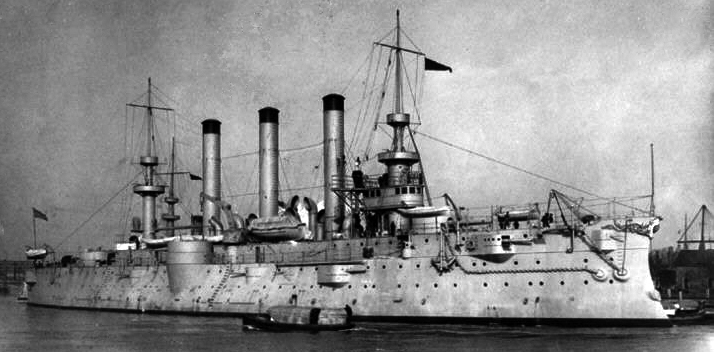

USS Brooklyn 1899
Design of the USS Brooklyn
Armament
The USS Brooklyn possessed a solid battery of eight 8 in (203 mm)/35 caliber Mark 3 guns or Mark 4 breech-loading rifles in four twin Mark 8 turrets in the French “lozenge” arrangement. The two side turrets were powered by an electric system while the other two were steam-driven to test the best system, which later concluded with the choice of electric ones. Secondary armament comprised twelve 5 in (127 mm)/40 caliber QF guns in side sponsons.
Tertiary armament comprised twelve 6-pdr (57 mm (2.2 in)) Driggs-Schroeder QF guns and four 1-pounder (37 mm (1.5 in)) Driggs-Schroeder saluting guns. For close-quarter combat, five 18 in (450 mm) torpedo tubes were located also in a lozenge. Since ths ship was susceptible to land US Marines, as well as some wheeled carriages for dismounted guns were also carried, including two 3-inch (76 mm) field guns and four Gatling guns to cover their land operations in depth, in addition to the ship’s main artillery. Refits consisted in removing her torpedo tubes before the Great War and in 1917 only eight 5-inch guns remained while two 3 in (76 mm)/50 AA guns were added in their place.
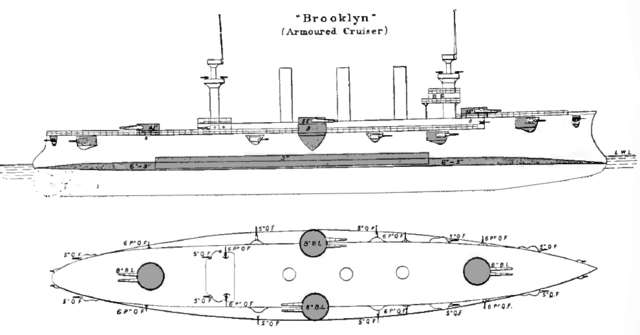
USS Brooklyn diagram – Brassey’s annual
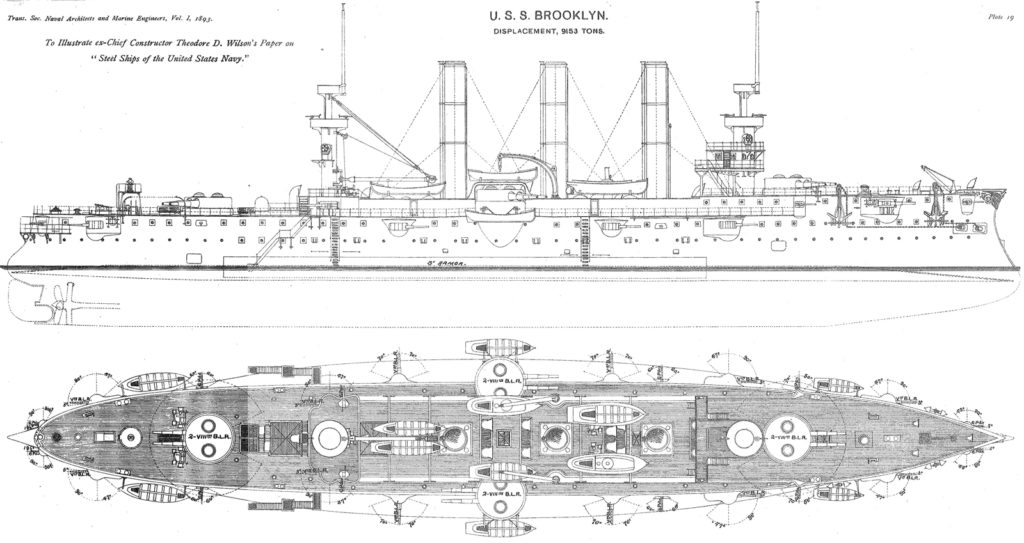
Detailed blueprint, from navsource.org
Protection
Compared to the USS new York, the USS Brooklyn’s own armour seemed like a let down, since the bar was raised for armament instead. The belt was 3 in (76 mm) thick, 8 ft 6 in (2.59 m) in height on the waterline, protecting the machinery. The armored deck was 6 in (152 mm) thick on the sloped sides, reduced to 3 in (76 mm) on horizontal amidships surface and 2 1⁄2 in (64 mm) in the ends. The gun turrets were protected by 140 mm and the barbettes (203–102 mm) with 3-in ammunition hoists. Gun sponsons for smaller caliber were still 4 in (102 mm). The conning tower was 8.5 in (216 mm) in thickness all in Harvey steel.

Propulsion
Brooklyn was intended to be relatively fast at 20 knots (37 km/h; 23 mph) on paper. She achieved 21.91 knots (40.58 km/h; 25.21 mph) on trials. Her machinery was generally similar to the USS New York, but she achieved 1,300 ihp (970 kW) additional horsepower, traduced by an extra knot on forced heat. The four triple-expansion engines amounted to 16,000 ihp (12,000 kW) and up to 18,769 ihp (13,996 kW) as shown by on trials. Each pair were clutched on one shafts.
The forward engines could be disconnected for long range cruises. This was a sound idea in principle, but a liability when an emeregency fell, as connecting these engines took time (too much in the case of the Battle of Santiago de Cuba). Indeed both USS New York and Brooklyn, shat shared this features, did not have a required speed to meet their adversaries. These VTE engines were fed by Seven coal-fired cylindrical boilers. These were of two types, five double-ended and two single-ended.
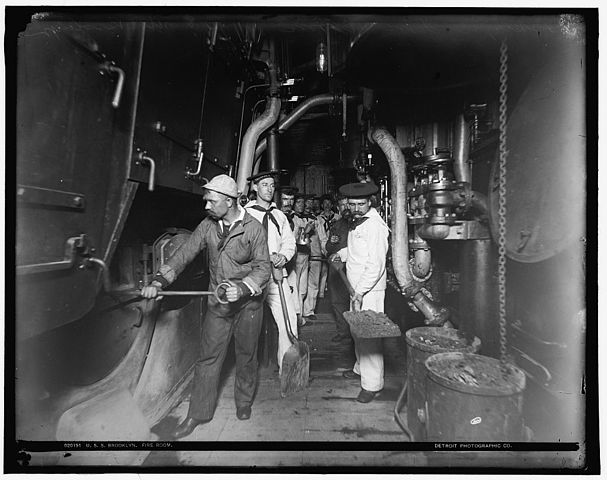
USS Brooklyn fire room
The USS Brooklyn in action
Of course the cruiser main involvement was the Spanish-American war, but the ship managed to stay in service throughout WW1 as well, and was retired in 1921 after a quarter of a century in service.
After a cruise to Britain to carry representatives of the U.S. government for the Diamond Jubilee of Queen Victoria, the USS Brooklyn was back to the east coast and the West Indies.
By March 1898 she served as flagship of the Flying Squadron under Commodore W. S. Schley. This Squadron was scrambled when the war broke out with Spain, and arrived at Cienfuegos, Cuba on 21 May. There, the fleet immediately operated a blockade. Five days after, the Squadron sailed to Santiago de Cuba, where the local Armada was located under the protection of the forts.
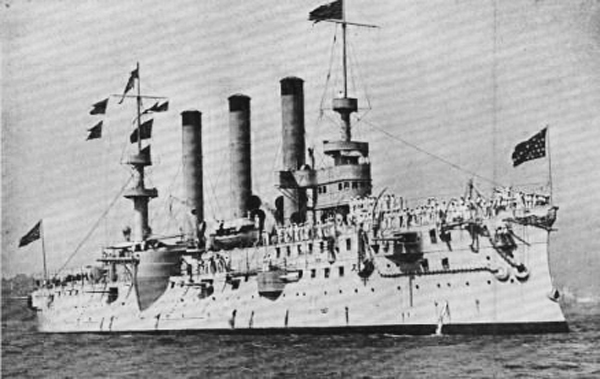
USS brooklyn ACR3 in 1898
The USS Brooklyn at Santiago de Cuba
USS Brooklyn became the hero of the Battle of Santiago de Cuba on 3 July:
At 09:35, a navigator of the armoured cruiser spotted and signalled a plume of smoke coming from the mouth of the port, allowing Schley to warn the entire fleet, and prepare for battle.
She engaged the Spanish most capable ships, Infanta Maria Teresa and Vizcaya both heading for her to try to protecte other ships. Both Spanish ships were also armoured cruisers, but of an older and lighter type, and certainly not of the same level as shown afterwards. Infanta Maria Teresa was the closest and by 10:05 it seemed brooklyn was headed right to her own bow at full speed, and possible collision course.
To avoid it, Schley ordered a sharp turn to starboard or “retrograde loop” that led her to a new collision course, this time with USS Texas ! Captain Philips of the battleship saw the danger and masterfully bring his ship to a complete stop, allowing the Brooklyn to run just in front of her ram, unhurt. After Infanta Maria Teresa and Vizcaya turned due West, Admiral Cervera ordered to engage Brooklyn in priority, as the fastest American ship present. The battleships indeed were easier to flee.
She was hit 20 times but suffered only one wounded and one KIA (Chief Yeoman George Henry Ellis) while destroying entirely the Infant Maria Teresa, with the deaths of most of Cervera’s bridge crew and setting the cruiser on fire as it appeared its fire-main was destroyed early. Cervera evetually ordered the cruiser to ran aground at 10:35 in shallows to save her crew. Later on Vizcaya was locked in a running gun duel for nearly an hour with Brooklyn.
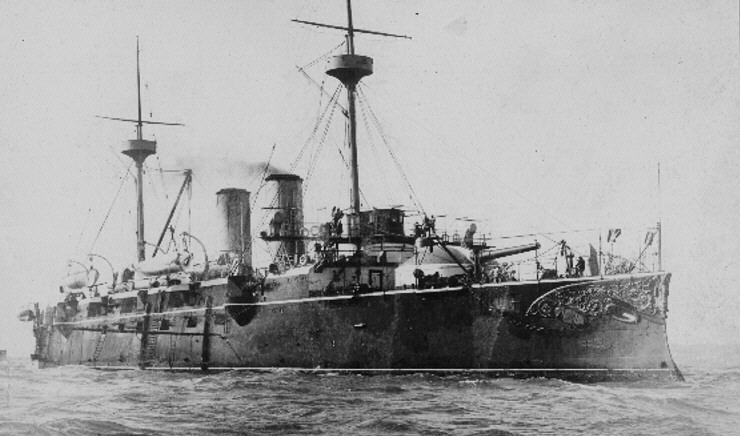
Spanish Cruiser Vizcaya
The duel side by side closed down to 1,200 yards (1,100 m), and the Spanish fire (about 300 shots) only caused the Brooklyn to loose a secondary gun while her return fire was much more precised and devastating. She literraly razed the Vizcaya and setting her ablaze from stem to stern, adding her 200 hits to those of USS texas that joined in.
The coup de grace was done by the Brooklyn, which closed to within 950 yards (870 m) and apparently hit with one of her 8 inches (203 mm) a torpedo to the point of being fired or the room behind (full or torpedoes or explosives), which resulted in a tremendous detonation. She grounded herself later. Both Spanish cruisers had allowed the Cristóbal Colón to flee Westwards, but by then the Brooklyn still short of two engines, not coupled, was her closest antagonist.
She fired at her, but could not maintain the chase at 16 knots. However USS Oregon could, and duelled with the Spanish cruiser to the finish as she burned her best reserves and was down to inferior grade coal and was headed for the coast and needed to turn, presenting her hull to the Oregon.
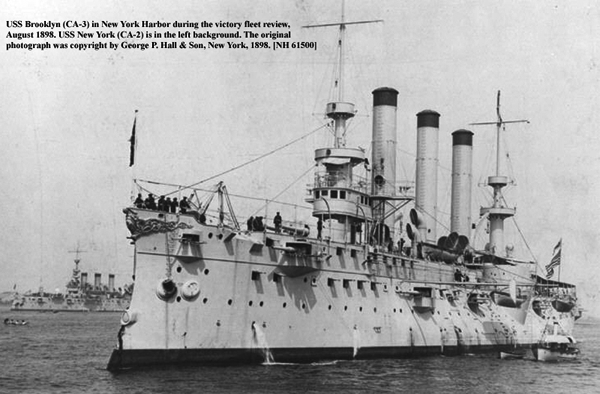
Brooklyn at the victory parade of the fleet in August 1898
The USS Brooklyn during the great war
The Brooklyn was taken after the battle in the Schley/Sampson controversy over credits of the battle. The American cruiser returned to Tompkinsville, New York on 20 August. She operated along the Atlantic coast and the Caribbean and participated in the Dewey Celebration at New York the next year. She sailed via the Suez Canal to Manila and became flagship of the Asiatic Squadron.
She took part in the US intervention in China until October 1900 and made a cruise from the Dutch East Indies to Australia and New Zealand and returned to the philippines until 1902 and back to New York Navy Yard. By 1902 she was back in Cuba, and the next year she participated in the intervention in Syria (September-October 1903) and in Djibouti the next year. She was back to New York in 1905, became flagship of Rear Admiral Charles Dwight Sigsbee and then sailed to Cherbourg, France, to carry the remains of the late John Paul Jones back to America, Annapolis.
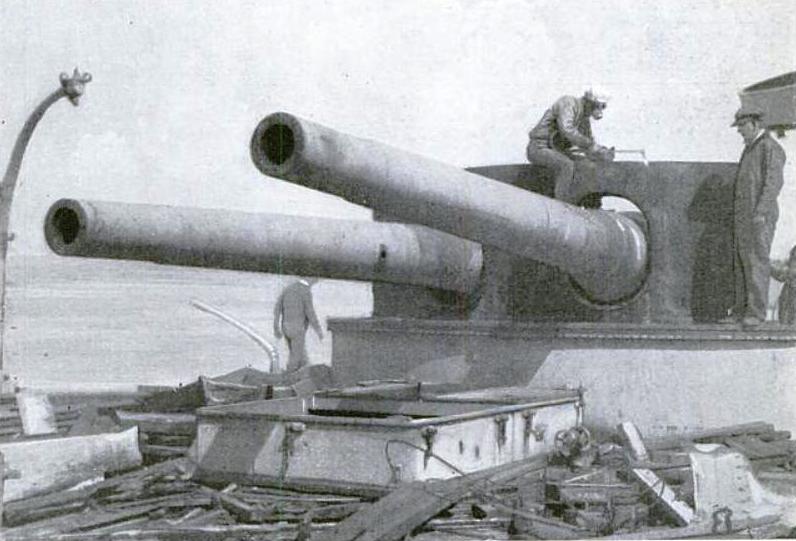
Closeup of the 8-in turret dismantled in 1921.
She made a naval militia cruise and a tour of the Mediterranean until May 1906. USS Brooklyn was placed when back home, into reserve at the League Island Navy Yard, Philadelphia in May 1906. From April to December 1907 she was displayed at the Jamestown Exposition, Virginia. She was recommissioned on 2 March 1914 and assigned to the Atlantic Reserve Fleet.
A receiving ship at Boston Navy Yard she went to full commission at Philadelphia in May 1915, part of the Atlantic Neutrality Patrol and then joined the Asiatic Station as flagship, conducting diplomatic missions in China, Japan, and Russia until 1919. In January 1920 to January 1921 she served as general HQ and flagship, redesignated as CA-3 from July 1920 and finally decommissionedat Mare Island Navy Yard in March 1921, and sold in December.

USS Brooklyn, Author’s illustration
Read More
Gardiner, Robert; Chesneau, Roger (1979). Conway’s All the World’s Fighting Ships, 1860–1905.
Burr, Lawrence. US Cruisers 1883–1904: The Birth of the Steel Navy. Oxford : Osprey, 2008.
Alden, John D. American Steel Navy: A Photographic History of the U.S. Navy from the Introduction of the Steel Hull in 1883 to the Cruise of the Great White Fleet (1989)
Brooklyn ACR3 on wikipedia
Spanwamwar website about the Brooklyn
More photos about the Brooklyn, 1896 Time documentary library of Congress
Naval & Heritage command
On navsource, including a superbly detailed blueprint

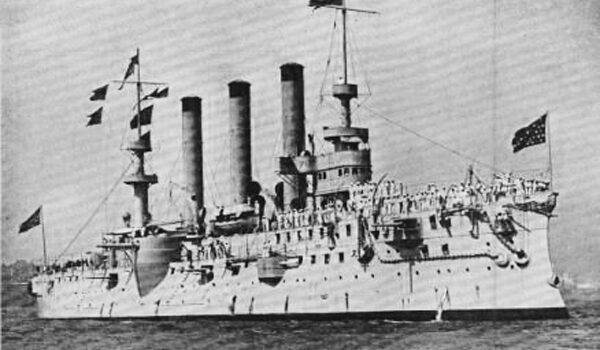
 Latest Facebook Entry -
Latest Facebook Entry -  X(Tweeter) Naval Encyclopedia's deck archive
X(Tweeter) Naval Encyclopedia's deck archive Instagram (@navalencyc)
Instagram (@navalencyc)





 French Navy
French Navy Royal Navy
Royal Navy Russian Navy
Russian Navy Armada Espanola
Armada Espanola Austrian Navy
Austrian Navy K.u.K. Kriegsmarine
K.u.K. Kriegsmarine Dansk Marine
Dansk Marine Nautiko Hellenon
Nautiko Hellenon Koninklije Marine 1870
Koninklije Marine 1870 Marinha do Brasil
Marinha do Brasil Osmanlı Donanması
Osmanlı Donanması Marina Do Peru
Marina Do Peru Marinha do Portugal
Marinha do Portugal Regia Marina 1870
Regia Marina 1870 Nihhon Kaigun 1870
Nihhon Kaigun 1870 Preußische Marine 1870
Preußische Marine 1870 Russkiy Flot 1870
Russkiy Flot 1870 Svenska marinen
Svenska marinen Søværnet
Søværnet Union Navy
Union Navy Confederate Navy
Confederate Navy Armada de Argentina
Armada de Argentina Imperial Chinese Navy
Imperial Chinese Navy Marinha do Portugal
Marinha do Portugal Mexico
Mexico Kaiserliche Marine
Kaiserliche Marine 1898 US Navy
1898 US Navy Sovietskiy Flot
Sovietskiy Flot Royal Canadian Navy
Royal Canadian Navy Royal Australian Navy
Royal Australian Navy RNZN Fleet
RNZN Fleet Chinese Navy 1937
Chinese Navy 1937 Kriegsmarine
Kriegsmarine Chilean Navy
Chilean Navy Danish Navy
Danish Navy Finnish Navy
Finnish Navy Hellenic Navy
Hellenic Navy Polish Navy
Polish Navy Romanian Navy
Romanian Navy Turkish Navy
Turkish Navy Royal Yugoslav Navy
Royal Yugoslav Navy Royal Thai Navy
Royal Thai Navy Minor Navies
Minor Navies Albania
Albania Austria
Austria Belgium
Belgium Columbia
Columbia Costa Rica
Costa Rica Cuba
Cuba Czechoslovakia
Czechoslovakia Dominican Republic
Dominican Republic Haiti
Haiti Hungary
Hungary Honduras
Honduras Estonia
Estonia Iceland
Iceland Eire
Eire Equador
Equador Iran
Iran Iraq
Iraq Latvia
Latvia Liberia
Liberia Lithuania
Lithuania Mandchukuo
Mandchukuo Morocco
Morocco Nicaragua
Nicaragua Persia
Persia San Salvador
San Salvador Sarawak
Sarawak Uruguay
Uruguay Venezuela
Venezuela Zanzibar
Zanzibar Warsaw Pact Navies
Warsaw Pact Navies Bulgaria
Bulgaria Hungary
Hungary

 Bundesmarine
Bundesmarine Dutch Navy
Dutch Navy Hellenic Navy
Hellenic Navy Marina Militare
Marina Militare Yugoslav Navy
Yugoslav Navy Chinese Navy
Chinese Navy Indian Navy
Indian Navy Indonesian Navy
Indonesian Navy JMSDF
JMSDF North Korean Navy
North Korean Navy Pakistani Navy
Pakistani Navy Philippines Navy
Philippines Navy ROKN
ROKN Rep. of Singapore Navy
Rep. of Singapore Navy Taiwanese Navy
Taiwanese Navy IDF Navy
IDF Navy Saudi Navy
Saudi Navy Royal New Zealand Navy
Royal New Zealand Navy Egyptian Navy
Egyptian Navy South African Navy
South African Navy






























 Ukrainian Navy
Ukrainian Navy dbodesign
dbodesign
I was surprised to see you have my youtube slide show video about the Brooklyn on this site. I have been researching the Brooklyn since 2003, you have a decent outline. I much enjoyed the Read.
Thank you Edward,
That was really a nice slidshow, lots of rare photos !
Any book project ?